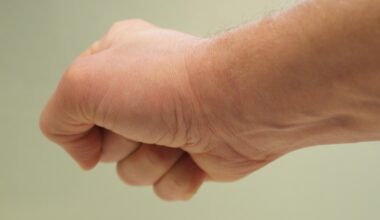Ninjutsu Weapons Training: An Introduction
Ninjutsu, often viewed as a mystical art of covert warfare, encompasses a wide range of skills, including weapon training. Practitioners, known as “shinobi,” learn to master various tools that enhance their combat effectiveness and survival techniques. Fundamental weapons in Ninjutsu include the shuriken, tanto, and bo staff. Each weapon serves a specific purpose, from throwing to close combat. Understanding the intricacies involved in wielding these weapons is crucial for practitioners. Proper training not only develops timing and precision but also instills discipline and respect. Engaging with these weapons fosters a deeper appreciation for Ninjutsu’s rich history. Specific techniques are often practiced repeatedly to ensure mastery and fluidity during a confrontation. Moreover, trainers focus on the psychological aspect, emphasizing the importance of mental agility in addition to physical training. A well-rounded approach ensures that students are prepared for both direct confrontation and tactical evasion. In this article, we will explore the essential weapons utilized in Ninjutsu and their operational contexts, laying a foundation for any student eager to delve deeper into this fascinating martial art.
Essential Ninjutsu Weapons
To understand Ninjutsu weapons training, we must first examine the essential tools. The four primary weapons commonly associated with Ninjutsu include the shuriken, tanto, bo, and naginata. Each carries historical significance and distinct applications. The shuriken, often referred to as throwing stars, can be used for distraction or to incapacitate an opponent from a distance. In contrast, the tanto is a short dagger that serves as an effective close-range combat tool. The bo staff, a long wooden pole, allows practitioners to engage in longer-range techniques while also providing defensive capabilities. Finally, the naginata combines a polearm with a curved blade, enabling versatile offensive and defensive maneuvers. Understanding the functionality of each weapon enhances strategic response during combat scenarios. Training with these weapons involves repetitive drills designed to build muscle memory and accuracy. Proper grip, stance, and footwork are integral components that lead to effective striking or throwing. Whether training against a partner or practicing alone, developing proficiency in these weapons requires dedication and focus.
In weapons training, safety and control play critical roles. Proper pseudo-weapons or training tools made of foam or wood are useful, especially for beginners. Practicing with these safe materials minimizes the risk of injury while developing skill. In addition to the physical aspect, an understanding of historical contexts enhances technique appreciation. Each weapon sports unique cultural significance and should be respected. During training sessions, instructors emphasize discipline essential for mastering Ninjutsu weapons. Students learn controlled movements and precision in each strike or throw, ensuring safety. Furthermore, the training environment fosters camaraderie among students. Practitioners often train in pairs or groups, encouraging communication and teamwork, critical elements in any martial art. Developing proper techniques and respectful habits leads to more effective training sessions and a smoother learning curve. Ninjutsu transcends mere physical capabilities; it is also about mental fortitude and emotional stability during high-pressure situations. Recognition of personal limitations allows students to grow at their own pace while gaining a deeper understanding of Ninjutsu as a holistic practice.
Physical Conditioning for Weapon Mastery
Physical conditioning forms a crucial element of Ninjutsu training, directly enhancing weapon proficiency. Building strength, flexibility, and endurance prepares practitioners for the rigors of training. Many martial artists incorporate various exercises, including cardio, strength training, and flexibility routines, into their regimens. Increased stamina allows students to maintain their energy during extended practice sessions or sparring matches. Proper warm-ups, including dynamic stretches, aid muscle flexibility, reducing injury risk. Furthermore, exercises targeting grip strength enhance control when handling weapons. A strong grip is particularly vital for executing techniques effectively, whether throwing a shuriken or delivering a precise cut with a tanto. Students are encouraged to engage in cross-training, exposing them to diverse conditioning methods, ultimately improving their overall combat effectiveness. Important components also include focusing on balance and core stability to ensure effective movement throughout their techniques. Incorporating martial arts-inspired fitness classes can yield additional benefits. A strong, conditioned body will enhance confidence during training and competitions, motivating students to pursue excellence. As practitioners hone their physical skills, they will notice significant improvements in their overall weapon handling and confidence in Ninjutsu.
Mental conditioning is equally important in shaping proficient Ninjutsu practitioners. Weapons training demands acute focus and discipline, which can be cultivated through mindfulness practices. Techniques such as deep breathing, meditation, and visualization prepare students mentally for training. Cultivating a calm and confident mindset is vital during high-pressure situations or competition. Visualization techniques, where practitioners mentally rehearse techniques, boost their confidence and performance. Additionally, spending time on the mental aspects of Ninjutsu can lead to better understanding and appreciation of the art. Students often learn to find balance between body and mind, enabling them to adapt their approach to combat or training situations. Engaging with other practitioners and sharing experiences fosters community support and motivation, essential for personal growth. Learning from each other’s successes and mistakes aids progress. In Ninjutsu, maintaining humility in training fosters character development, encouraging students to remain receptive to learning. Ultimately, developing a well-rounded approach to weapon training, encompassing both physical and mental aspects, leads to increased proficiency in Ninjutsu.
Conclusion and Further Development
In conclusion, Ninjutsu weapons training is an intricate journey that requires dedication and commitment. Understanding the historical relevance and operational contexts of each weapon sharpens a practitioner’s instinctive response in combat scenarios. Furthermore, cultivating mental focus alongside physical conditioning produces well-rounded participants. The path of mastering Ninjutsu weapons involves continuous practice, rivalling traditional martial arts in both form and technique. As students advance, they should seek additional educational resources such as instructors, manuals, or online platforms. Many skilled practitioners share their knowledge through workshops, seminars, and online videos, making it easier to access techniques. Exploring these options enables students to refine their skills beyond the dojo. Students may also consider joining Ninjutsu organizations and associations to immerse themselves in the community. Participating in competitions provides real-life opportunities to apply techniques acquired throughout training. Additionally, connecting with others in the martial arts community encourages a shared learning experience that leads to improvement. Mastering Ninjutsu weapons training is an ongoing process filled with challenges and rewards, ultimately creating a profound practice for all involved.
As the journey in Ninjutsu progresses, students should remain open-minded and adaptable to new techniques or strategies. Each weapon presents unique challenges, adjustments, and improvements to master. The evolution of Ninjutsu, like any martial art, embraces change over time. Learning from various instructors or styles broadens a practitioner’s perspective, enhancing creativity and adaptability during training. Communication with fellow students and instructors offers valuable insights into personal growth. Setting achievable goals and consistently reviewing progress keeps motivation high. Ninjutsu weapons training enables practitioners to cultivate self-discipline, focus, and a sense of respect. These essential qualities lead to overall personal development and improve interpersonal relationships. Moreover, participating in regular weapons training builds strong mental resilience that surpasses the dojo. Ultimately, the focus on ongoing learning creates a dynamic environment, fostering camaraderie through shared experiences. Embracing the entire spectrum of Ninjutsu weapons training allows students to benefit physically, mentally, and socially. Thus, armed with knowledge, techniques, and camaraderie, practitioners can embrace the true essence of Ninjutsu as a holistic lifestyle.
The Path Ahead in Ninjutsu
For those pursuing Ninjutsu weapons training, the path ahead is rife with endless possibilities. Continuous learning and adaptation enhance proficiency and deepen understanding. Regular engagement with instructors and practitioners keeps the learning environment vibrant. Incorporating various perspectives enriches training experiences and fosters camaraderie between students. Attending competitions and seminars exposes practitioners to diverse techniques and strategies. Such gatherings not only provide new insights but also inspire renewed motivation and commitment. As students hone their skills, it’s vital to remain aware of the importance of balance in training. Balancing physical conditioning with mental agility is crucial for advancements. Building relationships within the Ninjutsu community encourages personal growth. Additionally, participating in group classes allows practitioners to gain diverse perspectives. Keeping an open mind helps embrace various interpretations and styles of Ninjutsu. Engaging in discussions with fellow practitioners can inspire innovative training approaches. Moreover, documenting progress in a training journal, noting techniques learned and concepts explored, enhances personal growth. Ultimately, each practitioner of Ninjutsu can forge their unique path through dedicated training, exploration, and collaboration.


